Background
Pulse crops play an important role in sustainable farming systems however the lack of safe or suitable weed control options limits their use in Australian production. Herbicides are the main method of weed control in broadacre intensive farming systems and the development of herbicide tolerance traits in pulse crops has been identified as a major breeding priority.
The recent release and rapid adoption of the first herbicide tolerant lentil XT varieties demonstrates the likely demand for these traits in other pulse crops, particularly faba bean where no in-crop broadleaf weed control options are currently available. Additionally, the development of multiple herbicide tolerances, particularly for different modes of action, is important to ensure robust and sustainable weed control options into the future. This project explored a number of different strategies to develop lines with improved tolerance to key herbicides in faba bean, lentil and chickpea.
Screening current germplasm
Pulse crops currently have a narrow safety margin to many of the registered herbicides in pulses, such as metribuzin, and have been known to suffer yield losses in seasons conducive to damage. Field trials were conducted to evaluate varietal differences for metribuzin tolerance in faba bean, field pea and lentil lines using a range of rates applied post-emergent at the five node growth stage. Results showed that while faba bean lines AF03019 and Nura showed no significant yield loss at any rates, Farah and 1952/1 suffered significant yield loss at all rates when compared to untreated controls (Figure 1).
Similarly, in field pea lines, results showed that PBA Oura and Yarrum performed significantly better than Kaspa and Sturt at all rates (Figure 2). The same trends were also seen in lentils and confirmed genotypic variation for herbicide tolerance exists in the current germplasm.
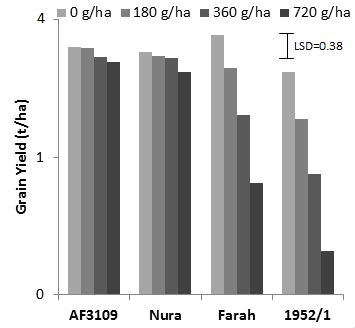
Figure 1: Yield response of faba bean lines with increasing rates of metribuzin, Turretfield 2012.
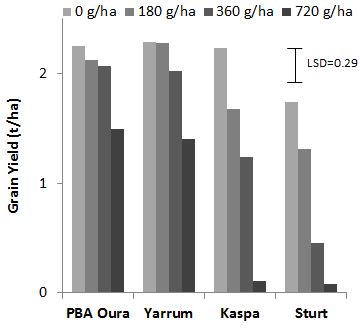
Figure 2: Yield response of field pea lines with increasing rates of metribuzin, Kybunga 2013.
Over 1000 diverse accessions (from the Australian Grains Genebank and PBA breeding material) of lentil and faba bean, and 200 of field pea, were screened for improved levels of metribuzin tolerance. From this, a number of the best selections were validated in controlled environment dose response studies and low levels of improved tolerance were confirmed in two lentil and four faba bean lines (Figure 3). While these low levels of improved tolerance are unlikely to be sufficient for new or novel herbicide applications, they will increase the safety margin to currently registered uses and are being incorporated into PBA breeding programs.
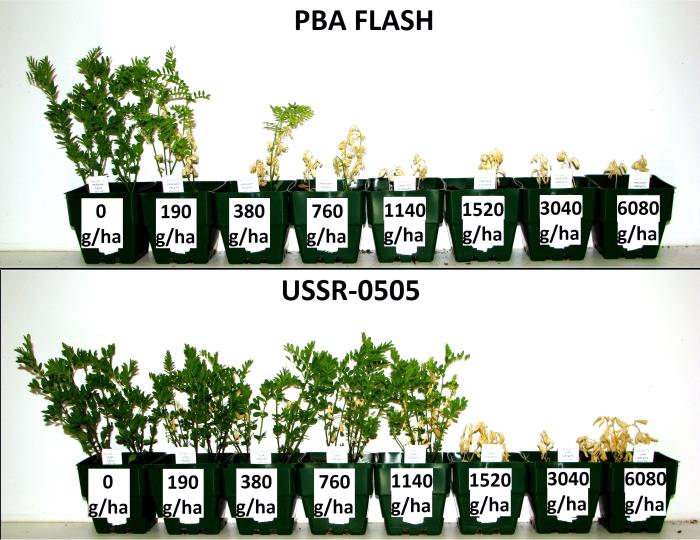
Figure 3: Lentil selection USSR-0505 showing a low level of improved tolerance compared to control cultivar PBA Flash.
Developing novel germplasm
Mutagenesis methods have been successfully used in the development of novel herbicide tolerance traits in a number of commercialized crops. In this project, mutagenized populations of lentil, faba bean and chickpea were screened for tolerance to a range of herbicides, and selections with high levels of putative tolerance were identified in each crop (Table 1). Details of the herbicide tolerant traits for each crop are described below.
Table 1: Summary of herbicide tolerant germplasm developed through mutagenesis methods
|
Faba Bean |
Lentils |
Chickpea |
|---|
| Mutated cultivar |
Nura |
PBA Flash |
PBA HatTrick |
|---|
| Herbicide |
imazapyr |
metribuzin |
clopyralid |
|---|
| Year/s screened |
2011 |
2011, 2012 |
2014 |
|---|
| Population size screened |
1.5 million M2 seeds |
22 million M2 & M3 seeds |
5 million M2 seeds |
|---|
| Field selections collected |
6 M2 plants |
95 M2 & M3 plants |
67 M2 plants |
|---|
| Lines progressed with herbicide tolerance trait |
4 lines |
2 lines |
50 lines |
|---|
| Level of improved tolerance developed |
High |
High |
High |
|---|
| Current status of validation |
Field validation 2014 |
Field validation 2015 |
Dose response experiments 2016 |
|---|
Faba Bean
Controlled environment dose response studies showed high levels of improved tolerance to imazapyr in all four faba bean lines, IMI-1, IMI-2, IMI-3 and IMI-4, though IMI-3 showed nearly twice the level of tolerance of the others. DNA sequence analysis found different mutation events on the ALS gene to be conferring herbicide tolerance, and molecular markers were developed to allow the rapid incorporation of these traits (Table 2). The field tolerances of the two best agronomically performing lines, IMI-1 and IMI-3, was compared using four different imidazolinone herbicides applied post emergent at the five node growth stage, and found that IMI-3 incurred no yield loss for any herbicides tested, while IMI-1 only suffered significant yield loss at high rates of imazapic (Figure 4).
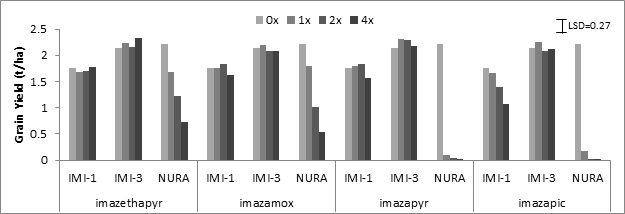
Figure 4: Yield response of IMI-1, IMI-3 and Nura at increasing rates of four different imidazolinone herbicides, Kybunga and Pinery 2014. LSD shown at p=0.05.
Laboratory and field trials evaluating cross tolerance to the other Group B chemistries were compared in faba bean selections and XT lentil varieties (Table 2). Independent results suggest that IMI-3 has a similar level of cross tolerance to the XT lentil varieties with improved tolerance to imidazolinone herbicides and flumetsulam, as well as a low level of improved tolerance to soil residues of some sulfonylurea herbicides (Table 2). On the other hand, while IMI-1 also shows improved tolerance to imidazolinone herbicides, it remains sensitive to flumetsulam and sulfonylurea herbicides (Table 2).
PBA faba bean has rapidly incorporated these traits into their elite breeding lines, with the most advanced material evaluated in South Australian yield trials during 2015 (Table 3). The average yield of breeding material incorporating the IMI-1 or IMI-3 tolerance was comparable to if not slightly better than the variety Nura. The best lines will be progressed to more widespread evaluation in 2016, and multiplication will be undertaken in parallel for potential commercialization in 2018 or 2019.
Table 2: Comparison of the relative tolerance levels of novel faba bean selections and lentil XT varieties from independent lab and field trials conducted as part of this and Southern Pulse Agronomy projects.
| Crop |
Line |
Mutation Event |
Molecular Marker? |
Imazapyr |
Imazapic |
Imazamox |
Imazapyther |
Flumetsulam |
Soil residuals of SU |
|---|
Lentil
|
PBA Hurricane XT |
197 |
Yes |
IT |
IT |
IT |
IT |
IT |
IT |
|---|
| PBA Herald XT |
197 |
Yes |
=H |
=H |
=H |
=H |
=H |
=H |
Faba Bean
|
IMI-1 |
653 |
Yes |
>H |
=H |
=H |
=H |
S |
S |
|---|
| IMI-2 |
205 |
Yes |
* |
* |
* |
* |
* |
* |
| IMI-3 |
205, ? |
Yes |
>H |
=H |
=H |
=H |
=H |
=H |
| IMI-4 |
205 |
Yes |
* |
* |
* |
* |
* |
* |
| IT = improved tolerance; =H = equal to PBA Hurricane XT; >H = greater than PBA Hurricane XT; S = sensitive; * = unknown/not yet tested |
|---|
Table 3: Average performance of elite faba bean breeding lines incorporating the IMI-1 or IMI-3 tolerance from Freeling, Pinery and Charlick PBA trials 2015.
| Pedigree |
Number of lines |
Relative Yield compared to Nura |
|---|
| AF05069-2-4* IMI-3-5-1 |
12 |
100-120% |
| AF07125-9* IMI-1-5-3 |
2 |
106-113% |
| AF08207-7* IMI-1-4-1 |
2 |
104-106% |
| AF08207-9* IMI-1-8-1 |
12 |
98-112% |
Lentil
Two lentil selections, 11SVHM043 and 12PAHM009, were confirmed to have a high level of metribuzin tolerance in 2013 dose response experiments (Figure 5). Field validation of both lines was undertaken during the 2015 season and confirmed high levels of tolerance in the mutated selections. DNA sequence analysis showed the same mutation event to confer tolerance for both lines and molecular markers have been developed. This trait is currently being incorporated by PBA lentil into elite breeding material.
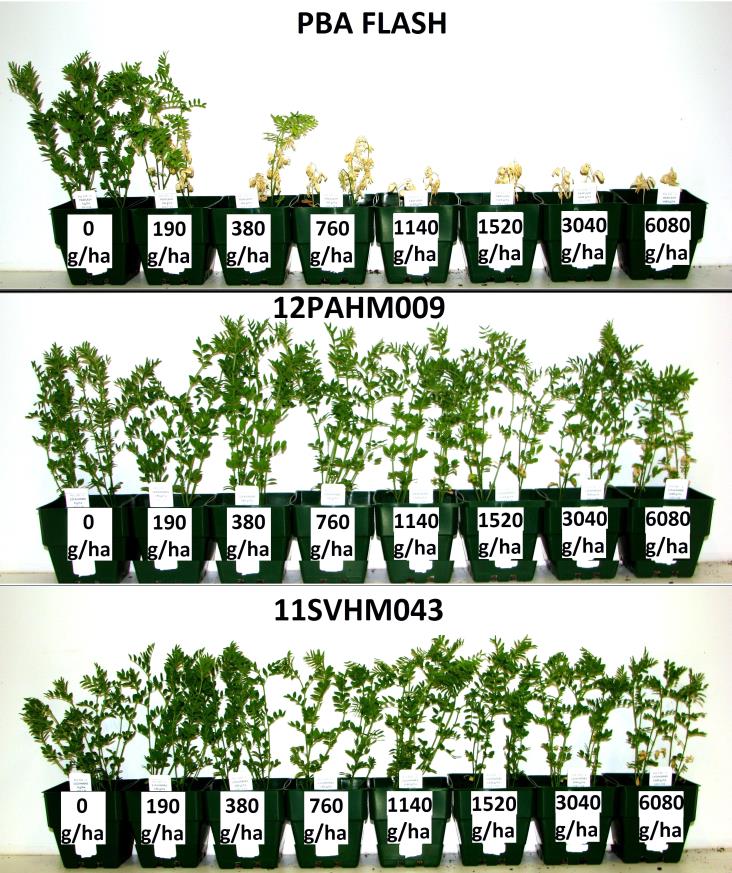
Figure 5: Tolerance levels of lentil selections 11SVHM043 and 12PAHM009 compared to control cultivar PBA Flash with increasing rates of metribuzin from controlled environment dose response studies.
Chickpea
Fifty chickpea lines were confirmed to have improved tolerance to clopyralid in progeny screen experiments, with preliminary experiments indicating a high level of tolerance in these lines (Figure 6).
All lines were bulked up during the 2015 season to multiply seed for future studies including dose experiments in 2016, and PBA Chickpea has started opportunistically incorporating lines with this trait into the breeding program.
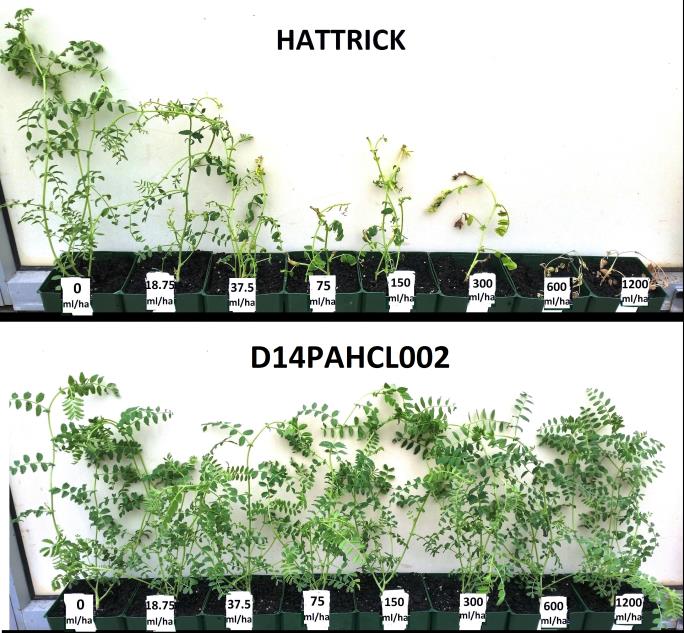
Figure 6: Photo from a preliminary clopyralid dose response showing improved tolerance levels of a chickpea selection D14PAHCL002 compared to control cultivar PBA HatTrick.
Summary and future work
The development of lines with low levels of herbicide tolerance from existing germplasm as well as high levels of improved tolerance from novel germplasm will help to improve grower confidence, expand weed control options and reduce the rotational limitations of pulse crops. All traits are being progressed in PBA breeding programs and new traits will continue to be evaluated in dose response and field trials as seed becomes available. Molecular markers will continue to be developed for all traits wherever possible, however this may be difficult in selections from existing germplasm with low levels of tolerance as they are likely to be complex (multi-gene) traits. Selections from novel germplasm can potentially carry deleterious genes and further work may be required to understand any limitations associated with these new traits. Further characterization of these traits, such as evaluation of tolerance levels to other herbicides with the same mode of action, is also required to allow the best registration opportunities to be pursued. Additionally, future work in developing tolerance to different herbicides with different modes of action is also necessary in lentils and faba bean, and could also be extended to other crops such as field pea, to ensure robust and sustainable weed control options into the future.
Acknowledgements
Funding for this work was provided through GRDC project DAS00131 - Improving weed management in pulse crops through herbicide tolerance—Part B (previously DAS00107) and their support is gratefully acknowledged. We also gratefully acknowledge the on-going help and support of the many research colleagues and farming collaborators whom without this work would not be possible, including the SARDI team at Clare, the University of Adelaide faba bean group, the University of Adelaide weed science research group, Mark Schilling, and many others.
Contact details
Dili Mao
9 Old North Road, Clare, SA, 5453
08 88426264






